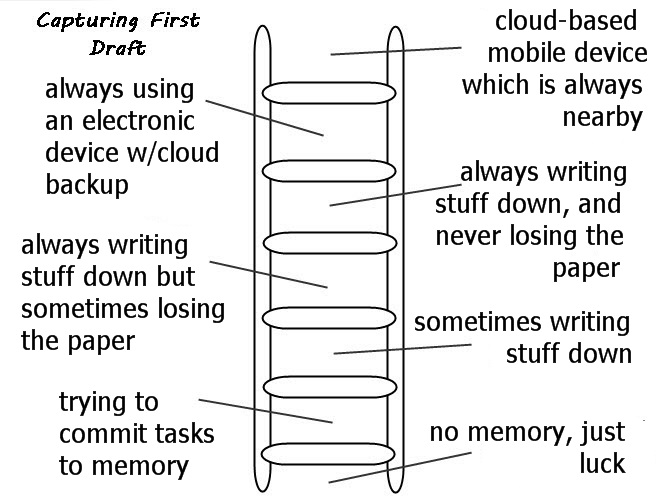coming up with four steps in all. As I described each level, I had to be honest: “I’m not as good as I think I am.” But that didn’t stop me. I was determined to reach someplace new.
The diagram below is a re-creation of the original, which is long lost.

When I completed the diagram, I sat back. This looked different to me. I had never seen a ladder of productivity skills like this one. I could also see my skills placed me somewhere in the middle – nowhere near the top.
It wasn’t hard to understand why: some of my productivity problems in Jamaica existed because I had never bothered to perfect the skill of Capturing at the highest level. When I didn’t Capture reliably, in the next moment, I left myself open to nasty surprises.
Fortunately, there were people I had worked with who had reached the top rung, but I had never seen the need to follow their example. Now, I could see why I needed to.
I flipped open a couple of productivity books and websites, thinking that I’d only succeeded in reinventing the wheel, but I only confirmed my first impression: I hadn’t seen anything like this before. In fact, the pages I opened all focused on defining a single set of behaviors.
For example, one author had perfected the art of “Capturing” with a digital voice-recorder rather than paper and pen, which he would play back each evening before going to bed. Like others, he seemed satisfied to tell readers that only a single rung of practices existed: the one he happened to be describing. He barely mentioned the possibility of other rungs, or even future, improved practices that might be invented to extend the ladder of “Capturing.”
“Finally, something new that I can use to get better,” I said to myself. “Just because I can’t easily find other ladders doesn’t mean I shouldn’t use it.”
It was a start.
Eventually, over the next few months, posts on productivity started taking over my blog, and I had to start a new one. “After all,” I reasoned, “I’m just fooling around. Once I run out of ideas, I’ll stop. Or maybe others might come along and use them. Just a few months at most, and then that will be it.” I was wrong. In 2014, I haven’t stopped.
***
Maybe you’re like me. You realize you’re stuck but don’t know why. I didn’t know how to get unstuck, even though the symptoms seemed clear enough. In this way, I was like millions of professionals who want to improve their time-based productivity but don’t know how.
You may also be facing a similar, perplexing life change that has brought all sorts of new commitments. You probably aren’t Jamaica after living in the USA for over two decades. But you may be experiencing some of the symptoms of life changes – information overload, email overwhelm, time stress, a feeling of being out of balance, or a sense of always being in a rush. Perhaps it extends to missed deadlines and commitments that are falling through the cracks.
Why aren’t there simple solutions to these problems?
In the chapters to come, I’ll show you that simple solutions don’t come easily to complex problems.
A Band-Aid is no substitute for open-heart surgery – and it’s not the Band-Aid’s fault, either. The heart is too complex system for such a simple solution. It takes years of training to understand its structure.
At the same time, the uninformed may see a YouTube video of a surgeon in action and accurately observe that the number of cuts being made with the scalpel to do a basic valve replacement surgery is fewer than 10. Given the fact that it takes more than 10 cuts to eat a 16 oz. Porterhouse steak, they’d mistakenly conclude that open-heart surgery, which requires fewer cuts, is easier.
Leonardo da Vinci once said, “Simplicity is the ultimate sophistication.”